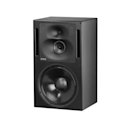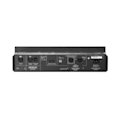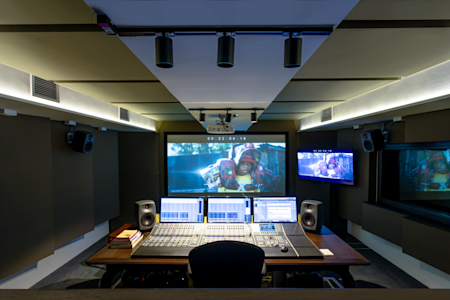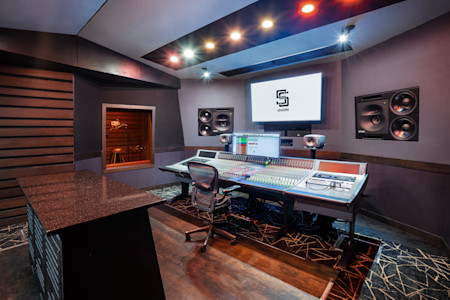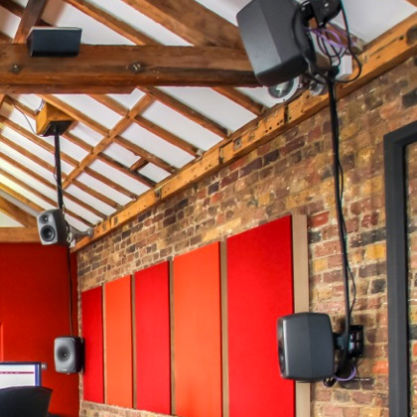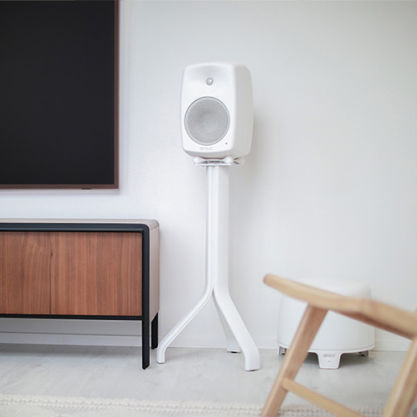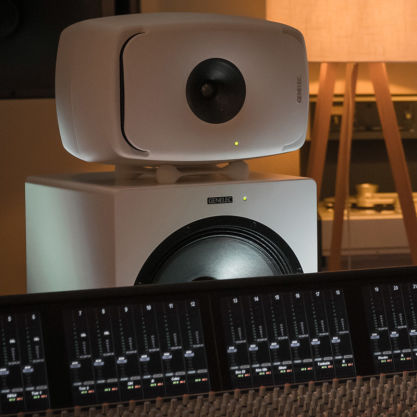Der 1238A ist unser größter Monitor mit drei Treibern. Er passt sich an Ihre Raumakustik an und liefert Präzision auf Referenzniveau auch bei hohen Schalldruckpegeln.
1238A
SAM™ Studio Monitor

Aktive Frequenzweichen

Directivity Control Waveguide (DCW™)-Technologie

SPL
121 dB

Frequenzgang
30 Hz - 22 kHz (-6 dB)

Abmessungen
H 810 x W 480 x D 420 mm, (Anzeige in Inch)

Leistung und Präzision
Der 1238A basiert auf dem renommierten 1038 und bietet die gleichen bewährten akustischen Eigenschaften, jetzt aber mit allen Vorteilen der Smart Active Monitoring-Technologie. Und dank des integrierten Verstärkermoduls RAM-L - das außerhalb des Gehäuses im Rack montiert werden kann - eignet sich der 1238A auch als Hauptabhörsystem mit Wandeinbau, das unübertroffene Neutralität mit einem erstaunlichen Peak-Schalldruckpegel von 121 dB verbindet.
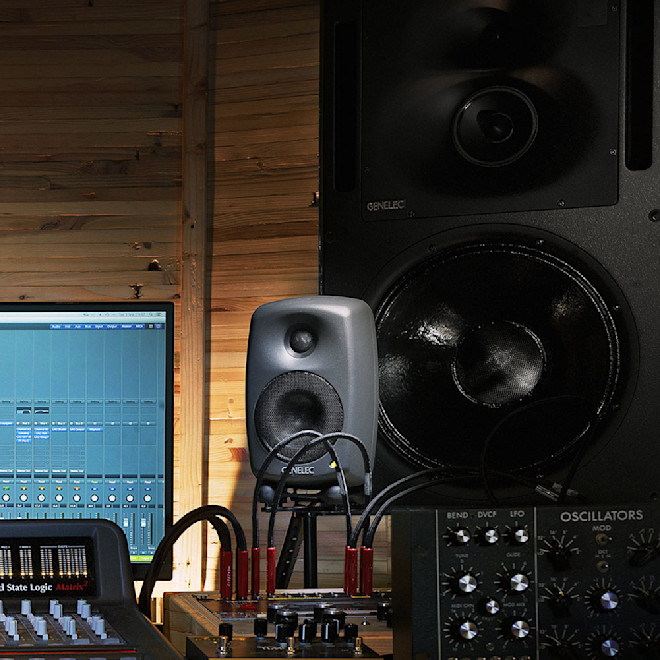
Wirklich optimiertes Hören
Zusätzlich zu seiner verlässlichen Transparenz lässt sich der 1238A mit unserer GLM Software steuern und kalibrieren. So werden störende Raumeinflüsse kompensiert, um eine wirklich optimierte Abhörlösung zu schaffen, von Mono bis Immersiv. Damit ist der 1238A die ideale Wahl für Profis in größeren Räumen, die auf eine perfekte Übertragung Ihrer Mischungen auf andere Studios und Systeme Wert legen.
Technische Spezifikationen

SPL
121 dB

Verstärkerleistung
500 W Bass (Class D) + 250 W Midrange (Class D) + 200 W Treble (Class AB)

Frequenzgang
30 Hz - 22 kHz ("-6 dB")

Genauigkeit des Frequenzgangs
± 2.5 dB (35 Hz - 20 kHz)

Treiberabmessungen
⌀ 385 mm Bass + ⌀ 125 mm Midrange + ⌀ 25 mm Treble (Anzeige in Inch)

Abmessungen
H 810 x W 480 x D 420 mm, (Anzeige in Inch)

Gewicht
57 kg / 125.7 lb

Anschlüsse
1 x XLR Analog Input
1 x XLR AES/EBU Input
1 x XLR AES/EBU Output
2 x RJ45 Control
1238A SAM™ Studio Monitor
SAM™ Studio Monitor
Technische Spezifikationen
Der 1238A ist unser größter Monitor mit drei Treibern. Er passt sich an Ihre Raumakustik an und liefert Präzision auf Referenzniveau auch bei hohen Schalldruckpegeln.
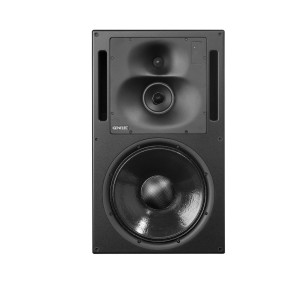
Systemspezifikationen
Frequenzgang
35 Hz - 20 kHz (± 2.5 dB)
Low cutoff -6dB
30 Hz
High cutoff -6dB
22 kHz

SPL
Peak SPL Maximum peak acoustic output per pair in a listening room with music material at 2 m.
≥124 dB
Kurzzeitiger max. SPL Maximum short term sine wave acoustic output on axis in half space, averaged from 100 Hz to 3 kHz at 1 m.
≥121 dB
Max. Langzeit-SPL Maximum long term RMS acoustic output in the same conditions with IEC weighted noise (limited by driver unit protection circuit) at 1 m.
≥116 dB
Eigenrauschen
Eigenrauschen Self generated noise level in free field at 1 m on axis (A-weighted).
≤10 dB SPL
Gewicht
Gewicht57 kg (125.7 lb)
Abmessungen
Höhe
810 mm
Breite
480 mm
Tiefe
420 mm
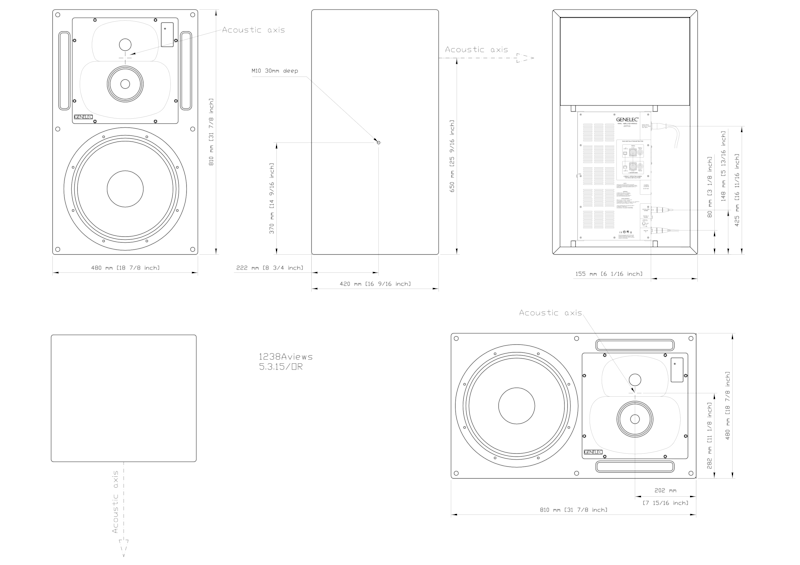
Gehäuse
Gehäusematerial
MDF
Gehäusetyp
Reflex port
Treiber
Treiber-Typ
Cone
385mm (15 in) cone
Durchmesser
385 mm
Treiber-Typ
Cone
125 mm (5 in) cone
Durchmesser
125 mm
Treiber-Typ
Metal dome
25mm (1 in) metal dome
Durchmesser
25 mm
Richtwirkung

Harmonische Verzerrung
> 200 Hz ≤0.5 %
Gruppen-Laufzeit
The latency at high frequencies from the input to the acoustic output, measured in the analog input:
Extended Phase Linearity in GLM set to OFF
5.1 ms
In Genelec performance graphics, the time of converting the from an electronic input signal to the acoustic output in a Genelec monitor is described by two factors – latency and group delay. The group delay factor can be read in the graphics for a specific frequency. The total frequency-specific input-to-output delay is a sum of the latency and group delay factors. To understand the significance of this total delay, consider that moving a loudspeaker away by 1 meter creates an additional delay of about 3 ms.
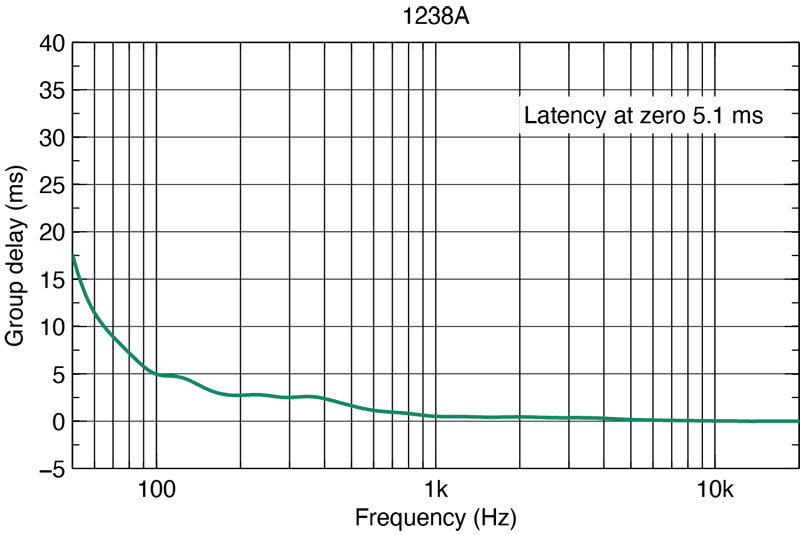
Abschnitt Verstärker
Verstärker
500 W Class D
Höhe
132 mm
Breite
483 mm
Tiefe
252 mm
Gewicht
6 kg
(13.2 lb)
250 W Class D
200 W Class AB
Netzspannung
100-240 VAC 50/60Hz
Stromverbrauch
ISS aktiv
≤0.5 W
Leerlauf
≤25 W
Volle Leistung
750 W
Abschnitt Signalverarbeitung
Anschlüsse
Input Analog signal input connector XLR female, balanced 10 kOhm.
Input Digital signal input connector XLR female 110 Ohm.
Output Digital signal output / Thru connector XLR male 110 Ohm.
2 x Control Two CAT5 (RJ45) GLM Network connectors for computer control using the Genelec Loudspeaker Manager (GLM) software.
Produktvarianten
Produktcodes
Weitere technische Details finden Sie in der Anleitung.
Schlüsseltechnologien

Aktive Frequenzweichen

Directivity Control Waveguide (DCW™)-Technologie

Intelligent Signal Sensing (ISS™)-Technologie

Schutzschaltungen

Optimierte Verstärker

Smart Active Monitor (SAM™)-Systeme
Aktive Frequenzweichen, die mit niedrigen Signalpegeln arbeiten.

Elektronische Frequenzweichen ermöglichen die Aufteilung des Audiosignals in einzelne Frequenzbänder, die separat an einzelne Leistungsverstärker geleitet werden können, die dann an spezifische, für ein bestimmtes Frequenzband optimierte Wandler angeschlossen werden.
Aktive Frequenzweichen gibt es sowohl in digitaler als auch in analoger Ausführung. Die digitalen aktiven Frequenzweichen von Genelec beinhalten zusätzliche Signalverarbeitung wie Schutzschaltungen, Verzögerung und Entzerrung.
Analoge aktive Frequenzweichen von Genelec enthalten elektronische Komponenten, die mit niedrigen Signalpegeln betrieben werden, die für die Eingänge von Leistungsverstärkern geeignet sind. Dies steht im Gegensatz zu passiven Frequenzweichen, die mit den hohen Signalpegeln der Endverstärkerausgänge arbeiten und dabei hohe Ströme und in einigen Fällen auch hohe Spannungen verarbeiten müssen.
In einem typischen 2-Wege-System benötigt die aktive Frequenzweiche zwei Leistungsverstärker - einen für den Tieftöner und einen für den Hochtöner.
Das Design der aktiven Frequenzweiche bietet mehrere Vorteile:
- Der Frequenzgang wird unabhängig von dynamischen Änderungen der elektrischen Eigenschaften des Treibers oder des Treiberpegels.
- Es besteht eine erhöhte Flexibilität und Präzision bei der Einstellung und Feinabstimmung jedes Ausgangsfrequenzgangs für die verwendeten Treiber.
- Jeder Treiber hat seine eigene Signalverarbeitung und seinen eigenen Leistungsverstärker. Dadurch wird jeder Treiber von den Treibersignalen der anderen Treiber isoliert, was Intermodulationsverzerrungen und Übersteuerungsprobleme reduziert.
- Empfindlichkeitsschwankungen zwischen den Treibern können kompensiert werden.
- Frequenz- und Phasenganganomalien, die mit den Eigenschaften eines Treibers innerhalb des vorgesehenen Durchlassbereichs verbunden sind, können kompensiert werden.
- Der neutrale Frequenzgang eines hochwertigen Aktivlautsprechers ist das Ergebnis der kombinierten Wirkung des Frequenzweichenfilters, des Leistungsverstärkers und der Treiber in einem Lautsprechergehäuse.
Die Verwendung des aktiven Ansatzes ermöglicht die Anpassung und Optimierung des Frequenzgangs des gesamten Lautsprechersystems in verschiedenen Raumumgebungen ohne teure externe Equalizer. Das Endergebnis ist ein einfacheres, zuverlässigeres, effizienteres, konsistenteres und präziseres aktives Lautsprechersystem.
Directivity Control Waveguide (DCW™)-Schallführung für ausgewogene Abstrahlung auf und außerhalb der Hörachse.

Mit der Entwicklung der Directivity Control Waveguide (DCW™)-Schallführung verfolgte Genelec 1983 einen revolutionären Ansatz. Sie wurde damals in einem eiförmigen Gehäuse eingesetzt. Über 30 Jahre entwickelt und immer weiter verfeinert, verbessert sie die Leistung von direkt abstrahlenden Mehrwege-Monitoren erheblich.
Die DCW-Technologie formt die abgestrahlte Wellenfront auf kontrollierte Weise und ermöglicht so eine vorhersehbare Anpassung des Abstrahlverhaltens (Dispersion). Um eine gleichmäßige und ausgewogene Richtcharakteristik zu erreichen, wird der Abstrahlwinkel begrenzt, so dass die Streustrahlung reduziert wird. Dies führt zu einer ausgezeichneten Linearität des gesamten Frequenzgangs sowie zu einem gleichmäßigen Leistungsverhalten. Frühe Reflexionen werden minimiert und man erreicht eine breite und kontrollierte Hörzone, mit einer akkuraten Klangwiedergabe auf und außerhalb der Achse.
Geringe Erstreflexionen und eine kontrollierte, konstante Richtwirkung haben einen weiteren wichtigen Vorteil: Die Frequenzbalance des Raumschallfeldes ist im Wesentlichen die gleiche wie die des Direktfeldes der Monitore. Das hat zur Folge, dass die Leistung des Abhörsystems weniger von den raumakustischen Eigenschaften abhängig ist.
Breite und Tiefe des Klangbildes, kritische Komponenten in jeder Hörumgebung, sind nicht nur für das Hören auf der Achse, sondern auch außerhalb der Achse wichtig. Davon profitieren auch anderen Personen im Raum, die nicht im Sweet Spot sitzen, wie es in großen Regieräumen oft der Fall ist.
DCW™-Technologie Hauptvorteile:
- Lineare On- und Off-Axis-Wiedergabe für einen größeren nutzbaren Hörbereich
- Erhöhtes Verhältnis von Direkt- zu Reflexionsschall für eine geringere Verfärbung durch den Abhörraum
- Verbesserte Stereoabbildung und Tiefenstaffelung
- Erhöhte Empfindlichkeit der Antriebseinheit um bis zu 6 dB
- Erhöhte Kapazität des maximalen Schalldruckpegels des Systems
- Geringere Verzerrung des Chassis
- Geringere Beugung an den Gehäusekanten
- Geringere Verzerrung des gesamten Systems
Intelligent Signal Sensing (ISS™) zur Reduzierung des Stromverbrauchs und automatische Nutzung des Standby-Modus.

Die Anfang 2013 eingeführte Intelligent Signal-Sensing-Technologie von Genelec wurde entwickelt, um sowohl die ErP-Richtlinien der Europäischen Union als auch die umfassenderen Nachhaltigkeitsverpflichtungen des Unternehmens zu erfüllen.
Die Intelligent Signal Sensing, ISS™-Schaltung verfolgt den Signaleingang des Lautsprechers und erkennt, ob er genutzt wird. Wenn der ISS-Schaltkreis über einen bestimmten Zeitraum kein Audiosignal am Eingang findet, versetzt er den Lautsprecher in einen energiesparenden Ruhezustand und der Lautsprecher verbraucht weniger als 0,5 Watt. Wenn ein Eingangssignal erkannt wird, schaltet sich der Lautsprecher sofort wieder ein.
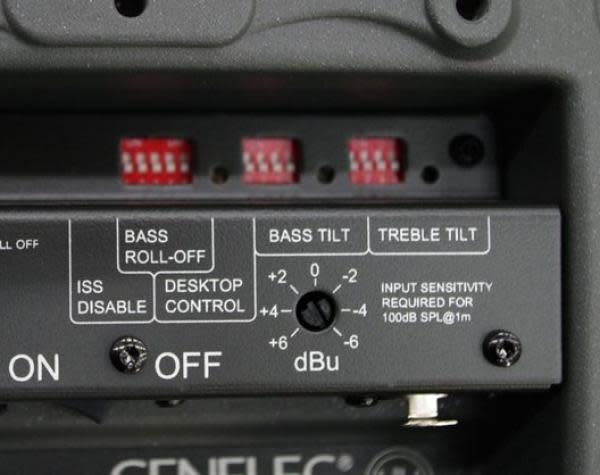
Wenn diese Funktion nicht genutzt werden soll, kann ISS™ deaktiviert werden, indem der DIP-Schalter "ISS Disable" auf der Rückseite in die Position "ON" gestellt wird. In diesem Modus wird der Monitor nur über den Netzschalter ein- und ausgeschaltet.
Beachten Sie, dass der Netzschalter den Monitor immer vollständig ausschaltet.
Nachfolgend finden Sie eine Liste der Bedingungen, die verhindern, dass der Monitor oder Subwoofer in den ISS-Ruhezustand versetzt wird:
- Am Analogeingang wird ein Signal erkannt.
- Am Digitaleingang wird ein Signal erkannt. Das kann auch das Clocking-Signal Ihrer Quelle sein, das auch anliegt, wenn kein Audio wiedergegeben wird.
- Das GLM-Netzwerk ist aktiv und GLM läuft. GLM 5 bietet eine eigene ISS Funktion an.
- ISS ist deaktiviert.
Es ist üblich, dass digitale Audioquellen das Clocking-Signal senden, sobald die Quelle eingeschaltet ist. Dies verhindert, dass der Monitor oder Subwoofer in den Ruhezustand übergeht. Es könnte auch ein Rauschen im analogen Eingangssignal vorhanden sein, das den Ruhezustand von ISS verhindert. Um herauszufinden, an welchem Eingang ein Signal anliegt, das das Umschalten in den ISS-Ruhezustand verhindert, entfernen Sie jedes Kabel einzeln und prüfen Sie, ob der ISS-Ruhezustand aktiviert wird.
Hochentwickelte Schutzschaltungen für die Treiber garantieren einen sicheren Betrieb.
In kritischen Produktionsumgebungen ist es unerlässlich, dass Abhörsysteme jederzeit zuverlässig und voll funktionsfähig arbeiten. Einer der Hauptgründe für den großen Erfolg von Genelec in Rundfunk- und Fernsehumgebungen ist die Zuverlässigkeit unserer Produkte. Ein Schlüsselelement für diese Zuverlässigkeit ist die interne Schutzschaltung, die seit 1978 in allen Produkten enthalten ist.
Die Schutzschaltung verhindert Treiberausfälle, indem sie Signalpegel erkennt und bei plötzlichen Pegelspitzen oder konstant zu hohen Pegeln den Signalpegel automatisch absenkt. Natürlich beeinträchtigt diese Funktion in keiner Weise die Klangqualität der Lautsprecher, wenn sie innerhalb der Spezifikationen arbeiten, sondern verhindert nur, dass zu hohe Eingangssignale den Lautsprecher zerstören.
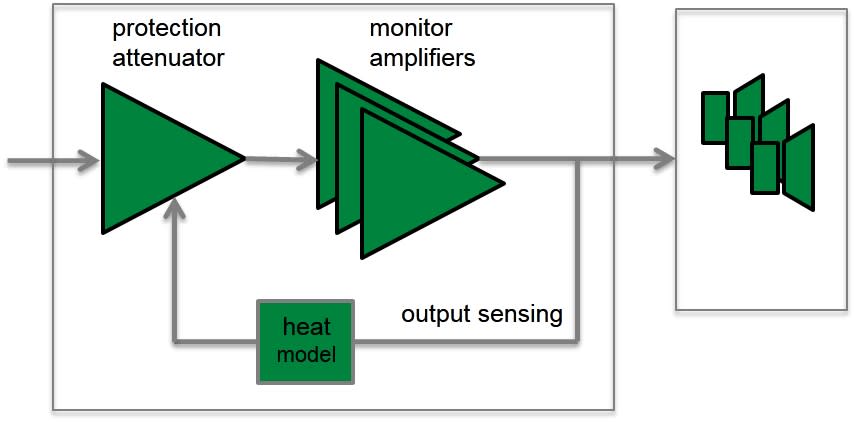
Merkmale und Vorteile der Schutzschaltungen:
- Reduziert den Ausgangspegel bei Bedarf (z. B. wenn die Temperatur der Schwingspule des Treibers den sicheren Grenzwert erreicht), was die Zuverlässigkeit des Systems erheblich verbessert
- Geeignete Schutzschaltungen in allen Lautsprechern und Subwoofern ermöglichen eine Maximierung des Systemausgangsschallpegels.
Jeder Treiber wird von einem eigenen, optimierten Verstärker angesteuert.

Elektronische Frequenzweichen ermöglichen es, das Audiosignal in einzelne Frequenzbänder aufzuteilen, die separat an einzelne Leistungsverstärker geleitet werden können, die dann an spezielle, für ein bestimmtes Frequenzband optimierte Schallwandler angeschlossen werden.
In einem typischen 2-Wege-Lautsprechersystem benötigt die aktive Frequenzweiche zwei Leistungsverstärker - einen für den Tieftöner und einen für den Hochtöner. Die Leistungsverstärker werden direkt an die Chassis eines Aktivlautsprechers angeschlossen, wodurch die Belastung des Leistungsverstärkers viel einfacher ermittelt werden kann. Jeder treiberspezifische Leistungsverstärker hat nur einen begrenzten Frequenzbereich zu verstärken (der Leistungsverstärker wird nach der aktiven Frequenzweiche platziert), was die Konstruktion noch einfacher macht.
Das Aktivprinzip bietet mehrere Vorteile:
- Die Leistungsverstärker sind direkt mit den Lautsprechertreibern verbunden, wodurch die Kontrolle durch die Dämpfung des Leistungsverstärkers auf die Schwingspule des Treibers maximiert und die Folgen dynamischer Änderungen der elektrischen Eigenschaften des Treibers verringert werden. Dies kann das Einschwingverhalten des Systems verbessern.
- Der Leistungsbedarf des Endverstärkers ist geringer. Da in den passiven Frequenzweichen-Filterkomponenten keine Energie verloren geht, wird die erforderliche Verstärkerleistung erheblich reduziert (in einigen Fällen um bis zu 50%), ohne dass die akustische Leistung des Lautsprechersystems verringert wird. Dadurch können Kosten gesenkt und die Audioqualität und Zuverlässigkeit des Systems erhöht werden.
- Kein Verlust zwischen Verstärker und Treibereinheiten führt zu einer maximalen akustischen Effizienz
- Mit aktiver Technologie kann eine überragende Klangleistung im Verhältnis zur Größe und zur Leistung bei niedrigen Frequenzen erzielt werden
- Alle Lautsprecher werden als werkseitig aufeinander abgestimmtes System geliefert (Verstärker, Frequenzweichen-Elektronik und Gehäuse-Treiber-Systeme)
Unsere vernetzten Smart Active Monitor (SAM™)-Systeme verfügen über eine automatische Anpassung an Ihre Hörumgebung.

In den letzten zehn Jahren hat die Erstellung von Medieninhalten weltweit rapide zugenommen, was zu erheblichen Veränderungen in der Art und Weise geführt hat, wie Einrichtungen mit der gestiegenen Arbeitsbelastung umgehen. Mehr denn je findet eine wachsende Zahl von Audioproduktionen in kleineren, engeren Arbeitsumgebungen statt. Dadurch verstärken sich häufig akustische Probleme und die Zuverlässigkeit beim Abhören sinkt. Gleichzeitig muss man sich als Profi auf ein präzises Abhörsystem verlassen können, das den Klang neutral und ohne Verfärbungen wiedergibt.
Aufbauend auf den bewährten elektroakustischen Grundlagen unserer Produkte der Serien 1200, 8000 und 7000 sind die fortschrittlichen SAM-Systeme von Genelec die modernsten und flexibelsten Abhörlösungen von heute. Sie sind ein unverzichtbares Werkzeug für Audioprofis, da sie sich automatisch an die akustische Umgebung anpassen und Pegel, Verzögerungen und Frequenzgang korrigieren können. SAM-Systeme können über das Genelec-eigene Loudspeaker Manager (GLM™)-Netzwerk und die entsprechende Software gesteuert werden, so dass Sie ein äußerst flexibles und zuverlässiges Abhörsystem aufbauen können.
Die GLM-Software ist ein intuitives und leistungsfähiges Monitorsteuerungs-Netzwerksystem, das die Verbindung zu allen SAM-Studiomonitoren und Subwoofern im Netzwerk verwaltet - mehr als 80 Geräte falls notwendig. Sie ermöglicht die Einstellung von Pegeln, Abstandsverzögerungen und eine Anpassung des Frequenzgangs mit dem intelligenten automatischen Kalibrierungsalgorithmus AutoCal™. Alle Parameter und Einstellungen werden in System-Setup-Dateien oder für den Stand Alone-Betrieb in jedem einzelnen Monitor oder Subwoofer gespeichert.
Außerdem können alle akustischen Eigenschaften der SAM-Systeme für verschiedene Arbeitsstile oder Kundenanforderungen optimiert werden. Auch ween Sie zwischen verschiedenen Räumen wechseln, können Sie von der SAM-Technologie profitieren und ein Höchstmaß an Konsistenz beim Monitoring erreichen.
Genelec SAM-Systeme bieten eine umfassend skalierbare, lösungsorientierte, intelligent vernetzte Produktpalette, die analoge und digitale Signale in praktisch jeder Arbeitsumgebung unterstützt.
Referenzen
Genelec UNIO Explained | How the ecosystem offers seamless in-room and personal headphone monitoring
Using GLM | Walkthrough
Using GLM | The foundations
Using GLM | Controlling GLM with MIDI
Using GLM | GRADE Room Acoustic Report
Using GLM | Calibration Group IDs
Using GLM | Accounts and product registration
Using GLM | The technical details
Genelec UNIO Explained | How the ecosystem offers seamless in-room and personal headphone monitoring
A quick guide to our UNIO Ecosystem – which offers audio engineers seamless bridging of in-room and personal headphone monitoring. https://genelec.com/UNIO
The Genelec UNIO Ecosystem – which combines the power of our renowned GLM, SAM Monitoring and Aural ID adaptive technologies – gives audio engineers the flexibility to work anywhere, anytime, from stereo to immersive. And now, with the new UNIO Personal Reference Monitoring (PRM) solution, audio professionals benefit from the pinpoint accuracy of our pioneering active monitoring headphone solution, which combines the 9320A SAM Reference Controller with uniquely factory-calibrated 8550A Professional Reference Headphones.
To learn more, visit https://genelec.com/UNIO
LowBeats magazine's online review of Genelec 1238A studio monitor and 7380A studio subwoofer. The review is in German.
{"fi-FI":"LowBeats magazine's [review](https://www.lowbeats.de/test-aktivmonitore-genelec-1238a-mit-subwoofer-7380a/ "Test Aktivmonitore Genelec 1238A + Subwoofer 7380A \u2013 Trio Grande") of Genelec 1238A studio monitor and 7380A studio subwoofer. The review is in German, and it is written by Jürgen Schröder. It was published on LowBeats website in September 2018.","ru-RU":"LowBeats magazine's [review](https://www.lowbeats.de/test-aktivmonitore-genelec-1238a-mit-subwoofer-7380a/ "Test Aktivmonitore Genelec 1238A + Subwoofer 7380A \u2013 Trio Grande") of Genelec 1238A studio monitor and 7380A studio subwoofer. The review is in German, and it is written by Jürgen Schröder. It was published on LowBeats website in September 2018.","de-DE":"LowBeats magazine's [review](https://www.lowbeats.de/test-aktivmonitore-genelec-1238a-mit-subwoofer-7380a/ "Test Aktivmonitore Genelec 1238A + Subwoofer 7380A \u2013 Trio Grande") of Genelec 1238A studio monitor and 7380A studio subwoofer. The review is in German, and it is written by Jürgen Schröder. It was published on LowBeats website in September 2018.","en-US":"LowBeats magazine's [review](https://www.lowbeats.de/test-aktivmonitore-genelec-1238a-mit-subwoofer-7380a/ "Test Aktivmonitore Genelec 1238A + Subwoofer 7380A \u2013 Trio Grande") of Genelec 1238A studio monitor and 7380A studio subwoofer. The review is in German, and it is written by Jürgen Schröder. It was published on LowBeats website in September 2018.","sv-SE":"LowBeats magazine's [review](https://www.lowbeats.de/test-aktivmonitore-genelec-1238a-mit-subwoofer-7380a/ "Test Aktivmonitore Genelec 1238A + Subwoofer 7380A \u2013 Trio Grande") of Genelec 1238A studio monitor and 7380A studio subwoofer. The review is in German, and it is written by Jürgen Schröder. It was published on LowBeats website in September 2018.","es-ES":"LowBeats magazine's [review](https://www.lowbeats.de/test-aktivmonitore-genelec-1238a-mit-subwoofer-7380a/ "Test Aktivmonitore Genelec 1238A + Subwoofer 7380A \u2013 Trio Grande") of Genelec 1238A studio monitor and 7380A studio subwoofer. The review is in German, and it is written by Jürgen Schröder. It was published on LowBeats website in September 2018.","ja-JP":"LowBeats magazine's [review](https://www.lowbeats.de/test-aktivmonitore-genelec-1238a-mit-subwoofer-7380a/ "Test Aktivmonitore Genelec 1238A + Subwoofer 7380A \u2013 Trio Grande") of Genelec 1238A studio monitor and 7380A studio subwoofer. The review is in German, and it is written by Jürgen Schröder. It was published on LowBeats website in September 2018."}
Händler finden

Dokumentation
Dokumente
Operating Manual 1238A 1238 三分频智能有源监听音箱 - Chinese SAM™ Series Full Line Catalogue In-Room Product Performance Immersive Solutions Brochure 1238A Operating Manual (Chinese)LowBeats magazine's online review of Genelec 1238A studio monitor and 7380A studio subwoofer. The review is in German.
LowBeats magazine's review of Genelec 1238A studio monitor and 7380A studio subwoofer. The review is in German, and it is written by Jürgen Schröder. It was published on LowBeats website in September 2018.









